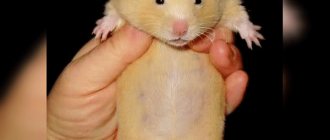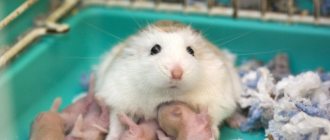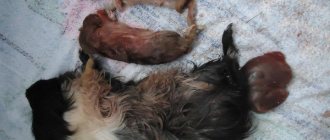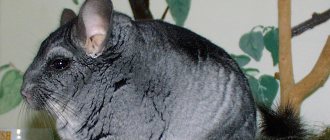Pregnancy in hamsters: identification, duration, care and other issues
Pregnancy of hamsters will not be long in coming if individuals of different sexes live in the same house.
An animal in “position” requires special care and the most caring attitude. Therefore, it is very important to understand in a timely manner that the hamster is pregnant. But recognizing the situation is only part of the story
To keep both the hamster and the babies alive, you need to know when the birth will occur, how to prepare for it and what to expect, and how to take care of the mother and her newborns.
How to tell if your hamster is “in position”
It is possible to determine that a hamster is pregnant by characteristic signs that appear both in the appearance of the female and in her behavior. A hamster is “pregnant” if she exhibits the following physiological signs of pregnancy:
there is no estrus (mature hamsters are able to reproduce every 4–5 days); the tummy swells (you can understand that the female is not just getting fat 7 days after mating - upon careful examination of the animal, seals like watery blisters can be felt in its stomach - these are developing fruits); nipples swell (this characteristic sign appears a week after mating); weight increases (for the first few days it remains the same, but after 10 days the hamster gains significant weight).
These signs of hamster pregnancy allow you to determine the period with an error of only a few days. A pregnant hamster looks quite characteristic. However, some signs are detected worse than others - for example, if the female has excess fat, it is difficult to notice a swollen belly or palpate the fruits. In such cases, it is difficult to determine the period.
You can also find out that a hamster is pregnant by changes in its behavior. Behavioral signs indicating the position of the animal include:
- increased appetite;
- increasing the volume of inventories;
- decline in activity (the pet does not want to play, is not easy to handle, often sleeps);
- change in gait (the animal moves smoothly, as if it is carrying itself);
- some fussiness;
- active preparation and arrangement of the nest.
All of these signs begin to appear especially clearly 10–12 days after mating. The less time remains before giving birth, the more the hamster changes. When the term comes to an end, the bloated female is all calm.
It is important to closely monitor the expectant parent. If during pregnancy the female unexpectedly lost weight, this is a signal that the animal has fallen ill or that her cubs, still inside the womb, have died
How to care for an expectant mother?
The rules by which you need to care for a pregnant hamster relate to issues of nutrition and maintenance of the animal.
The diet of a pregnant female should be balanced and contain proteins and calcium. The menu for every day should include:
- permitted herbs and greens;
- cereals;
- vegetables;
- low-fat dairy products without flavoring;
- eggs (beaten or boiled);
- boiled meat.
It is worth mixing a powdered tablet of ascorbic acid and calcium into drinking water. Late pregnancy in hamsters is accompanied by increased thirst, so the water in the drinking bowl needs to be updated as often as possible. The drink should not be cold, the recommended temperature is +18-21 °C. In addition to water, it is useful to give the expectant mother rosehip infusion and tomato juice.
A hamster that is “in position” sleeps a lot. Moreover, he falls asleep instantly and quite unexpectedly. The animal sleeps soundly, but the owner should still observe a quiet hour. There is no need to disturb your sleeping pet - in her sleep she replenishes expended energy. Sound, restful sleep will help her give birth to healthy babies.
In the room where the animal’s home is located, it is necessary to exclude temperature changes, drafts and humidity. Cleaning the cage should be done less frequently so as not to disturb your pet. It is also undesirable to move the cage.
Throughout pregnancy, it is important to give the female freedom of movement. If the life of the rodent is not in danger, it must be allowed to go for a walk outside the cage 1-2 times a day
Treatment of offspring
It is strictly forbidden to touch the baby hamsters - if the female smells a human scent on the baby, she will refuse it. If the birth was successful and the cubs do not need artificial feeding, they can be picked up 2 weeks after birth.
The acquaintance of hamsters with their owner occurs gradually. Babies from two weeks and older begin to accustom themselves to the owner’s hands and their smell. At this age, you can visually determine the sex of the cubs. 3-week-old hamsters are already allowed to play. At this point you should also return to regular cage cleaning.
What to feed a pregnant female
A pregnant hamster needs to create comfortable conditions, ensure complete peace and absence of stress. Remember that stressful situations can have a detrimental effect on the offspring, even to the point of a distraught mother devouring her children.
The hamster should also be provided with good nutrition. At this time, her diet should contain a lot of fruits, vegetables and products containing protein, which is so necessary during the development of the offspring in the womb . The latter include:
- egg white;
- chicken meat (boiled);
- baby food with meat;
- dairy products.
Learn more about hamster nutrition.
Also, at this moment the female urgently needs to replenish her body with minerals. To do this, place a chalk stone in the cage.
Important! Good nutrition for the mother will guarantee that she will not bite the babies to death.
.
How long does a hamster's pregnancy last?
No one doubts that a hamster can become pregnant only after contact with a male. Despite the fact that experienced breeders do not recommend keeping two or more small animals in one cage, since hamsters are quite territorial creatures, many purchase a couple of hamsters. Therefore, if you do not want unwanted mating to occur, ask the seller at the pet store to determine the sex of the animal.
The gestational age of hamsters and the duration of gestation depend on the breed. Djungarians bear offspring for 18–21 days. The average gestation period for a Syrian hamster is 16–18 days. Campbell hamsters and Chinese hamsters bear their young for 18–22 days. Pregnancy in Roborovsky hamsters lasts 23–30 days.
Furry pets give birth to 3 to 6 babies. Adult females give birth to more hamsters than young animals.
If you plan to breed hamsters, you need not only to know at what age these animals reach sexual maturity, but also to note the mating period. Puberty in hamsters occurs at the age of 3–4 months. At the same time, hamsters can become pregnant as early as 6–7 weeks, but still the optimal breeding period is from 4 to 10 months.
Is it possible to pick up small jungarians?
Experienced breeders do not advise touching or picking up babies until they reach two weeks of age. Also, until this time, it is worth climbing into the cage with your hands less often, only to carry out the necessary manipulations of replacing water and providing food. The litter is not changed at this time.
The most popular of all types of domestic hamsters is the Syrian; families with children love it.
The fact is that any careless actions can scare away the mother, and in this case she will stop fulfilling her parental responsibilities. There is a big risk that she will stop feeding the children if she smells someone else's smell on them.
How to tell if your hamster is “in position”
The following signs will help you understand that your hamster is pregnant with an error of a few days:
- No heat. In sexually mature pets, the readiness to reproduce occurs every 4-5 days.
- Enlarged tummy. A week after mating, upon careful inspection, you can feel fruits that look like bubbles of water.
- A decrease in the hamster's activity, refusal to play and a smooth gait will also help determine pregnancy. The closer the birth is, the calmer the female becomes.
- Weighing. In the first days of pregnancy, the weight of the rodent remains unchanged; after ten days of gestation, the female becomes significantly heavier.
- Swelling of the nipples after 7 days of mating.
Visible signs of your pet’s pregnancy can be observed 10-12 days after copulation. In addition to a rounded tummy, the animal exhibits changes in behavior. The female's appetite increases, she begins to prepare the nest, and her movements become fussy. Often, when trying to be picked up, the animal protests. The animal often falls asleep and also diligently stores food.
Important points during pregnancy
The gestation period for hamsters varies, depending on the breed of the animal. Hamsters begin to become pregnant at different ages, the most suitable being 4-10 months. But the chances of getting pregnant appear at 1-3 months.
The imminent appearance of offspring in a hamster radically changes the life of the owner and the animal itself. Firstly, it is necessary to separate the pot-bellied animal from the rest. Fights may occur between the female and the male, and as a result, someone will die. A pregnant pet becomes aggressive, and this behavior can also be observed while feeding the cubs.
The owner must move the animal into a glass container before giving birth. This is due to the fact that babies can fall out of a regular cage. Be sure to fill the bottom of the new housing with sawdust so that the layer is 5 cm. Water is suspended so that the kids do not reach it and drown. All entertainment toys of the animal are removed from the cage; they can be harmful to the life of the hamsters. Nothing should interfere with the mother during feeding.
During the first period of fruiting, tactile communication is still possible, but when the end of gestation comes, the pet cannot be touched. The female will be able to give birth on her own, without human help, especially since during this period she is very angry towards her owners.
Pet's appearance
A pregnant pet will gradually increase in size. The appearance of the Dzungarian breeds resembles a pear. It is difficult to find out that a Djungarian hamster is pregnant, since it has long and fluffy hair. The size of the abdomen depends on the number of offspring and the period. The nipples gradually enlarge and become visible from under the fur. In addition to external signs, there are also indirect ones, they are as follows:
lies in a ball; the appearance of anger; moves slowly and carefully; looks for secluded places to rest; prepares the place for childbirth; eats and drinks a lot.
How should I eat?
It is important to feed your pet the right and healthy foods during pregnancy. Food should be varied and healthy
The diet should consist of dry mixtures, sprouted grains, herbs, fresh fruits, and vegetables. In addition, the animal needs protein food.
Proper feeding is a must
Every day you need to give a boiled egg, low-fat cottage cheese and boiled chicken, not salted. The water needs to be changed every day, it should always be fresh. Vitamins such as glucose and calcium can be added to it. If there is one, put a small piece of chalk in the cage and let the animal chew it. It is very healthy and contains a lot of calcium.
Cleaning the cage
A general cleaning is required before giving birth in a cage. It is carried out 4-5 days before the birth itself. It is forbidden to clean 1-2 days in advance. The cage is thoroughly washed and disinfected. You cannot put down new bedding, as the female will be very nervous. At this time, it is advisable to disturb the expectant mother as little as possible. She herself prepares the house, as it will be convenient and comfortable for her.
She also stores food, so people don’t want to disturb her. Place any fabric, hay and bandages in the cage; they may be useful during childbirth. Place a small cardboard house in the shape of a house so that mothers can hide their newborn babies there. Since hamsters are nocturnal animals, it will be easier for them to give birth at night. If labor begins during the day, hang a towel on the cage so that the female thinks it is night.
How to recognize the birth process
Childbirth lasts approximately 3-6 hours for a dzhungarik. They usually do this on their own. It is forbidden to touch the mother during childbirth and after. It is also prohibited to do the following processes:
- make a lot of noise;
- make sudden movements near the animal;
- look at her and the babies, and also touch her with her hands.
If a mother is stressed, she may not want to feed her babies or eat them at all. She and the newborns should not be disturbed for 16 days. During this period it is forbidden to clean the cage
You can tidy up on day 10, but be careful and don’t touch the children
If you do not follow these rules, you may not be able to breed pets. If bearing offspring was difficult, then the female may treat the children poorly and not accept them. If during fruiting the female does not receive the necessary food, mainly protein products, then she can feast on her children.
Nutritional features of a pregnant hamster
In order for the female to bear and raise healthy young without being harmed, her diet must be supplemented with calcium, protein foods and vitamins. The following products should be included in the menu:
- chicken meat;
- low-fat cottage cheese;
- eggs;
- vegetables (beets, carrots);
- sprouted cereal seeds;
- greens, juicy herbs.
Of the first three listed components, one should be in the diet daily. You need to be careful with green and succulent foods so as not to cause diarrhea in your pet, but they must be included.
Little hamsters
The lack of calcium can be compensated for by adding a tablet containing this element, or simply crushed chalk, to drinking water. The same can be done with ascorbic acid.
It is better not to give perishable foods in large quantities, as the female can hide them, and this will further contribute to the development of various infections.
Complications during childbirth
Complications during childbirth
In most hamsters, childbirth proceeds easily and smoothly, but in some cases complications may arise that threaten the lives of the mother and babies.
Therefore, it is important for every hamster breeder to be able to not only recognize birth complications, but also provide their pet with qualified assistance
In most cases, birth complications in hamsters are related to toxicosis of pregnancy. If all the signs of this deviation are present, then the probability of death of the female and her offspring is very high, and the chances of saving the animal are negligible. As a rule, veterinarians suggest that the owner euthanize the pet, since further treatment is unlikely to yield any positive results and the animal will still die during or after birth.
Many owners show great concern if the female does not give birth to cubs on the estimated day of birth. There is no need to worry about this, especially if the animal behaves normally and eats with appetite. After all, it is very difficult to establish the exact time of birth: they can begin a little earlier or later than this period, which depends on the individual characteristics of the animal, conditions of keeping and feeding, as well as on the number of cubs being carried and many other reasons.
When the owner notices that the female is experiencing contractions, and her attempts last more than 15 minutes without any result, a veterinarian should be called. The help of a specialist is also necessary if, after the birth of one or two babies, more should be born, but this does not happen within 30 minutes.
If the female does not free the cubs from the membranes, they may die
Another common birth complication is the fetus getting stuck in the female's birth canal. The reason for this may be that the female is pregnant with one large baby. Additionally, delayed birth often occurs when the female is too old for her first pregnancy.
A sign of this complication is that the female strains and strains for 15 minutes, but her calf is never born. As a rule, a fetus stuck in the birth canal is born severely weakened or even dead. To save the female, the owner needs to call a veterinary specialist to the house.
A typical complication during birth of hamsters is the birth of the babies with the rear part of the body forward (in normal births, the offspring emerge from the birth canal head first). This deviation does not at all affect the course of labor, but can cause the death of the offspring. The fact is that after giving birth, the female instinctively begins to gnaw through the fetal membrane from the end that comes out first. And since in the case described above this will be the back of the baby’s body, the head will remain in the fetal membrane.
Newborn hamsters need mother's care
If the cub is strong, it will begin to squeak desperately, attracting the mother's attention. The latter will notice her mistake and, licking the baby, will free his head from the film.
Less viable babies are likely to die if they are not helped by the owner monitoring the progress of labor.
The intrauterine death of the cubs poses a huge danger to the life of the animal. Dead cubs are very rarely born to healthy females. This happens with improper, poor nutrition with insufficient amounts of vitamins and microelements, as well as with some infectious diseases.
If the animal is not helped in time, it will die. Therefore, if during pregnancy or during childbirth the owner notices that the movements of the fetuses have stopped, the female hamster must immediately be shown to a veterinarian who will artificially induce labor or perform a cesarean section.
If veterinarian intervention was not required and the female nevertheless gave birth to dead babies on her own, they can be pulled out of the nest with a spoon, being careful not to touch the living ones. But this is not at all necessary, because the female will eat them. This may not be very pleasant for the owner, but for the female, the dead cubs will become an additional source of protein.
Possible problems and complications
Djungarian hamsters often have health problems during pregnancy and childbirth:
- Toxicosis . It is extremely rare among Djungarians, but unlike people, it is dangerous for a pregnant female. In this case, toxicosis develops during childbirth and even after it. There is no treatment, so it is deadly for the mother (and often for the offspring).
- Pathologies of childbirth . Before mating hamsters, be sure to pay attention to their age. This is especially true for females older than one year. By this age, their pelvic organs lose elasticity, which makes it more difficult for them to give birth. If there are few cubs (2−3), then they are larger than usual. In such a situation, the only way to save the hamster and its offspring is through surgery.
- Fetal death . This is caused by an infection or genetic disease. To save the dwarf, you also cannot do without surgery.
- Endometritis . The first symptoms of the disease are bloody discharge with an unpleasant odor that does not stop for several days. This sign often indicates the presence of a dead fetus inside.
- Mastitis . Females feed their babies on their own, and often no problems arise. But if during lactation signs such as fever, redness and enlargement of the mammary glands, and loss of appetite are observed, this may indicate mastitis.
If any strange symptoms appear during pregnancy or childbirth, you need to show your Djungarian hamster to a veterinarian.
Caring for the safety of babies
To prevent your pet from eating the babies, try to clean the cage in advance of the birth. After the babies are born, access to the hamster’s home should be limited as much as possible. Do not pick him up for communication, do not try to touch or stroke the offspring. All that is required of the owner is to carefully clean the toilet area and put food in the cage. Place the hamster's house in a quiet and calm place, eliminating the occurrence of anxiety. Several rules will help protect the cubs from the aggressive behavior of the female:
- try to minimize stressful situations;
- do not add other hamsters to the cage;
- provide the rodent with adequate nutrition;
- allow females to give birth between 4 and 12 months of age;
By providing the pet with favorable conditions during gestation and the feeding period, the likelihood of eating its own young can be reduced to zero.
What conditions need to be created for successful reproduction?
To encourage hamsters to mate after uniting them under one roof, you should place a lamp in the immediate vicinity of the cage and direct the light from it into the cage. In this case, the animals will look for a dark corner in their home. This will certainly bring them closer.
The best option for mating would be a separate cage, carrier, or box . This way you can avoid conflict. If this is not possible, then the female is placed with the male, and not vice versa.
The mating cage should be spacious. The room temperature is not lower than 20°C and not higher than 25°C. The cage should be installed in a secluded place where there are no drafts, noise, heating devices, and away from other pets. It is advisable to remove all gaming accessories from it.
Find out more about hamsters: what breed of pet hamster to choose, how long do hamsters of different breeds live, how to train a hamster to respond to its name.
Do not abandon animals immediately after joining without supervision. If a serious fight breaks out, they will need to be seated. You can leave them alone only if it is clear that they like each other.
Since after conception the female will begin to build a nest, she needs to put materials in the cage - rags, cotton wool, clean paper, hay. Placing newspapers in the cage is strictly prohibited.
How to tell if a hamster is pregnant
Already at the age of a month, the animals begin puberty. For this reason, young animals should be kept separately.
The seller can easily convince an inexperienced buyer that this hamster looks so strange because it is “overweight.” It is possible to find out that it was a pregnant female only after an unplanned birth.
If the animal is an adult and the mating is planned, it is easier to determine that the hamster is pregnant. The owner should know the signs of heat in a female hamster. If estrus occurs after 3-5 days, offspring should not be expected. If there is no heat, you can wait for external signs of an interesting situation.
About a week after mating, you can try to examine the female with your hands (feel the fruits). The animal is placed with its front paws on the surface and clasped with its arms from behind. The thumbs will be on the back, and the rest will be on the stomach. By carefully palpating the abdomen from the ribs to the pelvic bones, you can feel the fruits. They feel like balls.
This method is only suitable for large and calm rodents; it is not informative with dwarfs. If signs of pregnancy are questionable, the female should be weighed. Weighings on precise scales are repeated regularly: at first the weight remains the same, but from the 10th day it quickly increases. Depending on the number of fruits and the type of hamster, the weight gain is up to 20 g. If the female loses weight, this is a serious sign of illness or missed pregnancy.
We improve living conditions
A pregnant woman definitely needs a house or a nest.
If there is no house in the enclosure, then from the beginning of pregnancy you need to take care of the future nest and provide the hamster with a large number of soft, non-scented napkins and scraps of warm textiles; the animal itself is able to prepare a cozy sleeping place for itself.
Any suitable sized cardboard box will be suitable as a house or shelter. In the absence of a box, it is better to block the ceiling and side walls of the cage from the penetration of bright light. After building a nest, the hamster’s home is strictly forbidden to be touched until the cubs reach 2 weeks of age.
Caring for the female and offspring after birth
Keeping and caring for a Djungarian hamster after giving birth will not cause much trouble. For the first 2 weeks, the female is constantly in the nest with her offspring. He only goes out to eat and drink. To prevent the hamster from leaving the children for a long time, it is advisable to place a feeder and drinking bowl near the house.
Until Djungarian hamster puppies are 2 weeks old, you do not need to touch or lift them. If the mother smells a foreign odor, she may abandon the puppies and even eat them. The cage is not cleaned until the hamsters are old. If necessary, you can partially replace the filler with a spoon. They do this when the female is in the nest, so as not to disturb her again.
Djungarian hamsters grow very quickly. On the fifth day, their ears are raised, and now the children can hear. After a week, they try the food that mom brings: finely chopped carrots, greens. At the age of 2 weeks the baby begins to appear. From now on you can train them manually. Dzungarik is given to new owners a month after birth.
Pregnancy in Djungarian hamsters is easy. The main thing is to take care of the expectant mother during this important period. He needs peace, proper care and good nutrition.
One source
How long does pregnancy last in different breeds of hamsters?
The duration depends on the breed of the animal, but generally it lasts 16-20 days, and this is a very short period of time compared to other mammals. However, it is better to consider these terms in detail depending on the type of hamster.
- Syrian hamster. Rodents of this breed begin to give birth earlier than anyone else - just 16-17 days from conception. The average number of heirs is 6-12, but sometimes there are 16-18 heirs.
- Dzungarik. Pregnancy of dwarf rodents lasts 18-21 days. The number of babies is 4-7, but in rare cases it can reach up to nine.
The only regularity for all breeds: the duration depends on the number of fetuses in the uterus; the more babies, the earlier the birth will begin.
Childbirth is usually easy and the mother does not need the help of strangers. After the babies appear, you should not wash the cage until they open their eyes and begin to move confidently. You should not touch the crumbs - because of the foreign smell, the hamster may eat them. In the first week, it is generally better not to touch the young family so that they do not have stress. Give food, water, and leave the cleaning for later. Place the cage in a dark place where they will not be disturbed.
How do dzhungarikas reproduce?
Among the Djungarians, sexual intercourse lasts on average 300 seconds, and the process of first acquaintance and rubbing in is from twenty minutes to half an hour. Most often, mating occurs at night. The hamster gets close to his partner several times with short breaks.
You should not be too nervous if, after intimacy, the male lies down, barely catching his breath - mating is a very energy-consuming event, so the rodent must rest properly in order to gain strength. After mating, the couple should be well fed.
Caring for a pregnant hamster
Pregnant rodents have very different needs from non-pregnant females. The cubs develop in record time, exhausting the expectant mother. The food should be high in calories, quickly absorbed and not have a negative effect on pregnancy.
In addition to prohibited foods, you do not need to give most fruits, berries and vegetables, for example, apples, pears, raw potatoes, onions, garlic, horseradish and stumps are prohibited.
Can be eaten - carrots, pumpkin, zucchini, cucumbers, squash, green peas, bell peppers. Treat your pet every day, with pieces up to one centimeter long. Sometimes it is allowed to treat the animal with slightly dried dill. Oat and wheat sprouts have a beneficial effect. A pregnant female should be fed food that does not contain harmful chemical compounds. Products must be peeled and, if absolutely necessary, soaked in clean water.
For the development of babies, a pregnant rodent must eat food enriched with protein and Ca at least 2 times a week.
- Grainy cottage cheese without fat.
- 1% classic yogurt.
- Boiled egg (chicken or quail).
- Boiled meat without adding spices (rabbit, chicken, beef).
The key source of strength and energy remains a mixture of grains. Dry food must be of very high quality, and it must be given more than during normal periods, because the feeling of hunger increases. An excellent addition to food for rodents would be herb rings with aromatic alfalfa, as they are enriched with vitamins and calcium, and if the female does not eat the rings, then they need to be soaked in warm water and she will eat them with appetite.
The hamster consumes much more water during gestation; this should not scare the owner. You need to pour fresh water into the drinking bowl every day. If desired, you can add liquid vitamins to the drinker.
If you are planning to breed hamsters, you definitely need to know how long pregnancy lasts for Djungarian or Syrian hamsters. This will ensure that you receive proper care and can react quickly if the birth does not go according to plan.
What happens during birth in hamsters?
Eventually, there will come a time when the hamsters are ready to be born. Your hamster will handle the birth quite successfully on his own, so you don't need to intervene. Although Syrian males should not be kept with a female during the gestation period. In dwarf hamsters such as the Djungarian and Campbell's hamsters, males sometimes stay with the female. If this is the case, then you should separate the male and female immediately after birth.
The number of babies you can expect in a litter depends on the breed, as well as the individual characteristics of the hamster.
Syrian hamsters usually have 6 to 10 hamsters per litter, while Djungarian and Campbell's dwarf hamsters usually have 5-6. Hamsters have been known to give birth to more than 15 babies, so be prepared!
Baby hamsters are born blind and hairless and must be protected by their mother in her nest. You should not touch newborn hamsters or disturb the nest. After 4 weeks, the babies become mature and each of them can be placed in a separate cage (in the case of Syrian hamsters). At this age, female dwarf hamsters (Djungarian, Campbell and Roborovsky) can be left with their mother, but males should be placed in a separate cage.
Pregnancy and the birth of offspring in hamsters is an important period in the life of not only the rodents themselves, but also their owners. Although the period of bearing babies does not last long, during this period it is necessary to provide your pet with care and follow all the rules for caring for it. Learn how to care for a pregnant hamster and keep the mother and future offspring healthy.
Solo content or in company
Campbell's hamsters get along well together. Sometimes the female and male jungariki are loyal to each other. But this is rather an exception to the rule. Fighting for territory is more typical for these rodents, so it is better to keep them separately, placing the female with the male only during mating. Even a Campbell's hamster will do better alone before giving birth.
Don't handle small hamsters with your bare hands
We improve living conditions
If the animal’s cage is not equipped with an additional internal house or other “shelter” where the female can place her babies, you should take care of this immediately after the news of the upcoming replenishment.
You don't have to buy a house. The construction of the nest can be left to the hamster directly. She will happily arrange the “nursery” on her own
It is important to help her with building materials. All kinds of shreds and napkins (without aromatic additives) are perfect for this role.
The basis of the house can be a cardboard box of the appropriate size.
After the female has completed construction, touching the hamsters’ home is strictly prohibited. This ban lasts until the newborn reaches 2 weeks of age.
Establishing pregnancy
So, we found out at what age a female is able to become pregnant and how long this period lasts. Now let's find out how to understand that a female hamster is pregnant.
- The first sign is a uniformly rounded belly. But it can only be distinguished from the 10th day of pregnancy.
- The second sign is the sudden and pronounced appearance of the nipples. Typically, a female hamster's nipples are light and pale. During pregnancy, they become bright pink and stand out against the background of the fur.
- The third sign is an increase in appetite. The expectant mother eats everything in her bowl with the energy of a vacuum cleaner. And he looks through the bars of the cage at the owner, waiting for more.
- The fourth sign is a change in behavior. An affectionate and tame girl becomes a real fury. When trying to pick her up, he uses his teeth.
- The fifth sign is nest building. The future hamster mother begins to fuss and build herself a nest from scrap materials.
If the owner notices these signs in his pet, the pet store will sell him a lady with a “surprise”.
When can you take hamsters away from their mother?
Hamsters are born absolutely helpless: they are blind, deaf, completely hairless and red; for minimal orientation in space and finding the mother, the babies have a slightly developed sense of smell. In general, they are completely dependent on their mother and are very vulnerable - little hamsters will not survive without their mother until they are 10 days old! Some development features:
- on the 5th day the first fur appears;
- at the age of a week, babies begin to try solid food;
- on the 14th day the eyes begin to open;
- On days 20–21, lactation ends completely and the babies switch to independent feeding.
Did you know? At birth, the weight of a baby hamster does not exceed 2 g, and its size is only 10
–
15 mm!
Around this time, they can be taken from their mother and placed in separate cages. The maximum period until which animals can be kept together is 5 weeks. Keeping pets together for longer is very dangerous, since by nature they are loners and are very jealous of their territory.
Thus, the appearance of offspring in hamsters is a rather exciting, but extremely responsible process. You should not allow pets to reproduce at random, because pregnancy and childbirth are a difficult task for females. Therefore, the birth of small hamsters must be approached responsibly, the intervals between pregnancies must be observed, the female must be given the opportunity to fully recover and the most appropriately provided comfortable conditions for the pet so that the life of her and the babies is safe!
How does pregnancy proceed and how long does pregnancy last in hamsters?
The production of offspring is a special stage in the life of animals and a responsible one for pet owners. Since hamsters do not live very long (about 2 years, with the best care they live up to 3.5), they become adults at the age of 5 weeks, but pregnancy in such young females is still undesirable.
Considering this and the fact that most species of hamsters are territorial animals, it is recommended to keep them separately. And if you plan to breed rodents, you need to know how to determine if a hamster is pregnant in order to provide her with the necessary nutrition and care.
How do hamsters give birth?
Not every owner is able to witness the birth of their animal, since in most cases the birth of offspring occurs at night. Despite this, it is worth knowing the features and signs of the appearance of babies, as well as possible complications in the female and the procedure for action in such a situation.
Sure signs of approaching labor and its course
You can find out that your pregnancy is about to end by the following signs:
- the animal stops eating;
- activity decreases;
- the birth canal opens.
What to do, how to help a hamster give birth
As such, human assistance is not required when giving birth to a hamster. The main task is to provide comfortable conditions for the expectant mother:
- 1-3 days before giving birth, you need to clean and wash the cage (it is better to use a one-story one for a pregnant female), replace the filler, and supply food that does not spoil.
- It is necessary to maintain an optimal temperature (21–24 °C) in the room and avoid drafts.
- It is advisable to place the cage with the expectant mother in a secluded, quiet, cozy place where nothing will disturb her.
- A pregnant or lactating female should not be frightened, picked up or touched again.
- It is strictly forbidden to keep a male and a female in the same cage, and not only during pregnancy and lactation, but at any time at all! Animals of different sexes should be placed in different cages immediately after mating.
These are the main manipulations that you need to carry out before giving birth. If a female gives birth during the day in your presence, you can simply observe. However, if there are a lot of offspring and the female cannot cope, you can try to provide help: carefully wrap some of the babies in a paper napkin to remove mucus and amniotic sac, then cut the umbilical cord a little above the belly and return them back to the cage with the rest of the babies.
Under no circumstances should you interfere with the process if the female begins to eat the offspring after giving birth.
Possible complications
Complications can occur both during childbirth and after the birth of offspring:
- Toxicosis. Occurs in the last days before giving birth; the female and her brood may die during childbirth or shortly after. There is no therapy for this condition.
- Death of offspring in the womb. Occurs due to poor nutrition, infections, age, physiological characteristics or genetics. If surgery to remove the uterus is not performed, the female will soon die from blood poisoning.
- Prolonged labor. They arise due to age over 12 months (in females, over time, the pelvic bones lose elasticity), due to the large size of the cubs, especially if there are few of them in the brood. In this case, unproductive contractions occur - the fetus does not pass through the pelvic bones even with strong and numerous contractions. In this case, surgery is necessary.
- Mastitis. Disease of the mammary glands occurs soon after childbirth and leads to lack of lactation and inflammation.
- Endometritis. Inflammation of the uterus also occurs soon after childbirth, manifested by bloody, unpleasant-smelling discharge that lasts more than 3 days.
Birth of babies
The main signs of an approaching birth of a hamster (step by step):
- the birth canal opens;
- the pelvic bones diverge;
- The vaginal membrane disappears.
When there are several hours left before giving birth, the hamster practically does not move and eats almost nothing. The birth itself takes place quite quickly - 3-5 minutes for the birth of each hamster. It is difficult to control the process - hamsters usually give birth at night.
During birth, the hamster is in a sitting position. After contractions, she speeds up the birth of the baby by pulling it out with her teeth. She then rips open the placenta, chews the umbilical cord, and licks the tiny newborn. After the birth process is complete (the birth of all the babies in the litter), the female eats part of the remaining placenta.
If during the birth process the pet is confused or hesitates, it is the owner’s responsibility to help her. You need to carefully grab the hamster with a soft napkin (under no circumstances should you touch the baby with your hand), then with light movements (as if massaging), the tiny body should be cleaned of mucus and released from the fetal membrane. The umbilical cord is cut with sterile scissors. After these steps, you need to put the baby under the mother’s belly and make sure that she accepts (licks) him.











